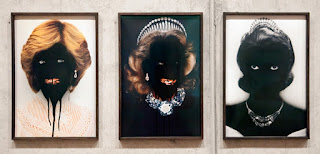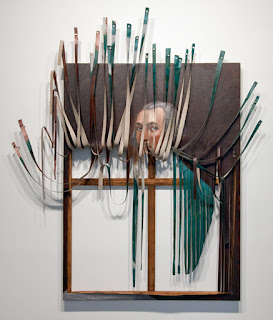National Gallery of Victoria, Melbourne, Australia
 |
| From "Enclave," by Richard Mosse |
The NGV, as it is commonly known, has a split personality
and is literally divided into two campuses.
The Ian Potter Center: NGV Australia specializes in art of
Australian origins, both indigenous and not, from colonial to contemporary. It
is a major responsibility for a continent-sized country.
But then again, the NGV International, like so many
“encyclopedic” museums in other cities around the globe, attempts to represent
the entire rest of the world.
I spent more time in the Ian Potter Center but I managed to
catch a few things at the International as well.
Here is a very small selection of things that caught my eye.
Ian Potter Center: NGV Australia
In this multi-media installation by Adam Goodrum, the
immaterial aspects—cast light and shadows on the walls—seemed more substantial
than the sculptural bit made of polymer resin at its center.
I very much enjoyed the indigenous works on display, some of
which were historical and some contemporary.
This detail from a painted Eucalyptus pole was made in 2003
by Gawirrin Gumana of the Guyamirrilil people of the Northern Territory.
I especially enjoyed seeing traditional works displayed
in proximity to more modern and non-indigenous works of art.
Having recently experienced Australian wildlife for the
first time ever, I was drawn to indigenous representations such as this
kangaroo by Robin Nganjmirra of the Northern Territory.
I’d seen kangaroos several times in the wild by this point
in my trip. This one, however, was in a wildlife park, which enabled me to get
close up and personal. In fact, they eat out of your hand like goats in a
petting zoo.
However, I learned the hard way not to let the emus eat from
my hand. Fierce creatures; they definitely bore a familial resemblance to
velociraptors.
This sculpted representation was made from actual emu
feathers and other fibres by Treahna Hamm of Wodonga, Victoria.
This modern piece was made circa 1962 by Godfrey Miller and
titled Trees in Quarry. Like many Australians, Miller was educated in Europe
before moving back to Sydney and an art career.
My favorite works in the Ian Potter Center were a roomful of
altered photographs by Tony Garifalakis. This set of three demonstrates the
tone, technique and style of the rest. Collectively called Bloodlines, The
suite of 12 portraits of royal families have been ruthlessly defaced with black
enamel paint.
I also liked the architecture of the building, which clearly
eschews the straight and plumb of traditional structural forms. The exterior of
the building, which I neglected to photograph (mentally kicking myself), looked
like a child’s play structure that had been knocked down and rebuilt several
times before the child went on to other things. The aerial shot (above) I borrowed from a website called Culture Victoria.
This is a shot of the interior showing a little of the
complexity of the spatial relationships and off-kilter lines of the
architecture.
Outside, there were several very intriguing, if hard to decipher, relief sculptures set into the very irregular paving bricks of the huge plaza.
NGV International
I can’t do this museum justice. I blitzed past most of the
collection in order to see contemporary work on the top floor. Just three
examples:
This sculptural mural made of painted wire by Mira Gojak is
entitled “Unending herd of blue.” The artist intended it to represent the
progression of Western art from the earliest cave paintings through Renaissance
development of perspective and chiaroscuro to Modern art’s concern for the
picture plane. Not to mention the tension between the drawing-like linearity
and three-dimensional space. (Then again, maybe it wasn’t the artist who had
all those grandiose intentions, but the curator who wrote up the wall label.)
Sarcasm and hyperbole aside, I enjoyed its scale and playfulness.
This painting, slashed as you see it, is by an “American”
named Titus Kaphar. When visiting a foreign museum, even the U.S. artists
represented are unfamiliar ones. The work is entitled “Stripes.”
The real reason I went to the NGV International was to see
“Enclave,” the video installation by Richard Mosse, which I saw listed in the
promotional brochure at the Ian Potter Center. I’d heard of Mosse and seen
stills of his powerful infrared images, taken in war-ravaged Democratic
Republic of the Congo. But stills cannot convey the power of the video. Even a
single video screen online cannot really represent the power of the
installation, which employs at least 6 enormous video monitors at various
angles throughout a large, darkened gallery. The monitors cannot all be taken
in at once and if you move around to see them all it is as if you are amongst
the people in the videos themselves. Very immersive and the more moving for it.
To see an interview with Richard Mosse and get a sense of the content of the video, go to Vimeo.
“Enclave” was my favorite work of art of all that I saw in
Australia--and I saw a lot of great work! Click here to read my review of the Adelaide Gallery of Art.
Richard Mosse image credits: Louisiana Museum of Modern Art website.

















No comments:
Post a Comment